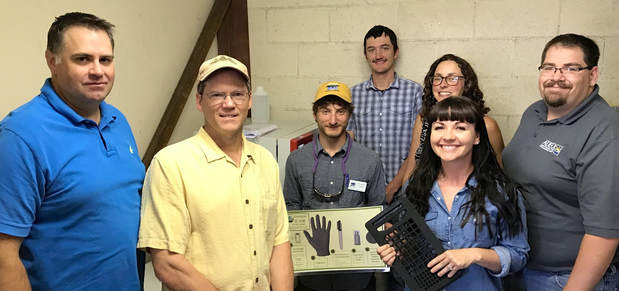Don’t miss this month’s chance to walk, volunteer, and attend important community meetings with Jack Welch! Find this month’s Walk the Walk schedule here. Thanks as always, Jack!
Daily Archives: July 31, 2017
Sampling for E. coli in our Watershed
E(ek!) Coli Sampling for the Safety of Humans and the Environment
Guest blog post to Flagstaff STEM City by Chelsea Silva, VISTA Member for the City Sustainability Department and the Friends of the Rio de Flag
Escherichia coli, more commonly known as E. coli, is a type of fecal coliform bacteria. Bacteria are single celled microorganisms that can either exist as independent organisms or depend on another organism to live. E. coli bacteria are found in the environment (soil and vegetation) and in the intestines and feces of all warm-blooded animals and humans. That’s right, fecal = relating to feces = poop!

E. coli image courtesy of the Center for Disease Control
Most coliform bacteria are not harmful, but their presence in drinking water indicates that disease-causing organisms (e.g. pathogens) could be in the water system. Only particular strains of E. coli cause serious illness, and people usually contact these strains (especially strain 0157:H7) through consuming undercooked meats such as hamburger. Disease symptoms include diarrhea, cramps, nausea, and sometimes jaundice, plus headache and fatigue.
Safeguarding against E. coli is part of the Arizona Department of Environmental Quality’s (ADEQ) mission to protect and enhance public health and the environment. The ADEQ conducts routine E. coli sampling throughout the state in order to reduce the risk of illness from disease causing organisms associated with sewage or animal wastes.

Meghan Smart (ADEQ) illustrates the use of the E.coli processor to Jake, Chelsea, and Oren
On June 28th, ADEQ staff trained staff and volunteers with Natural Channel Designs, Inc. and the Friends of the Rio de Flag on E. coli sampling. Trainees learned how to properly collect a water sample, how to process the sample using a handy “Processing Guide”, and how to record the data once processing is complete. Sampling in Flagstaff and the surrounding areas will provide the ADEQ with the data needed to protect our drinking water supplies.

The Processing Guide leads trainees through the E. coli testing procedure
Below show the initial and the final stage of processing the E. coli. After the sample incubates for 12 hours, you look at the large and small squares on the sample and count the ones that fluoresce under a black light.You then use a Most Probable Number (MPN) table to calculate the MPN of E. coli in the sample (you count the # large squares fluorescing in you sample and find this number on the X axis and do the same with the number of small squares fluorescing and find it on the Y axis to calculate the MPN of bacteria in the sample). The picture here shows that the sample contains bacteria, but not at a concerning level.
 Initial water sample before processing |
 Sample under black light after processing |
The Friends of the Rio de Flag is excited to partner with ADEQ and Natural Channel Designs, Inc. to engage citizen scientists in E. coli sampling. In the coming months, the Friends of the Rio will create a sampling plan with ADEQ to best fit the needs of our watershed. Afterwards, the Friends of the Rio will recruit volunteers to collect water samples throughout town. This will give us a better idea of water quality in our community.
Thank you to Meghan and Jake with the ADEQ for training us on E. coli sampling, and another thank you to Natural Channel Designs, Inc. for hosting the E. coli sample training day.

From L to R: Chris Tressler, Civil Engineer and Geomorphologist, Natural Channel Designs, Inc.; Mark Wirtanen, Biologist and Engineering Technician, Natural Channel Designs, Inc.; Oren Thomas, Conservation Projects Manager, Prescott Creeks; Jake Fleishman, Civil Engineering In-Training, Natural Channel Designs, Inc.; Chelsea Silva, STEM VISTA Member for Friends of the Rio de Flag and the City of Flagstaff Sustainability Division; Meghan Smart, Hydrologist, ADEQ; and Jake Breedlove, Grant & Watershed Coordinator, ADEQ
